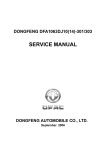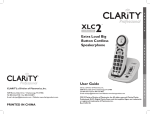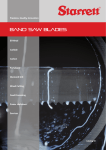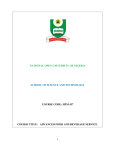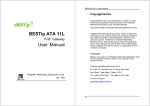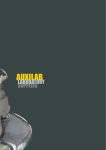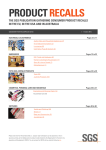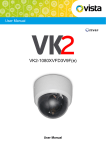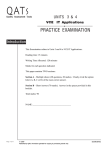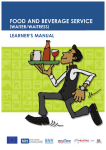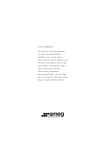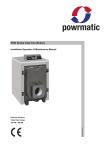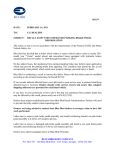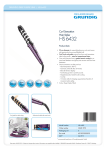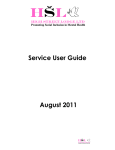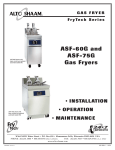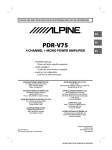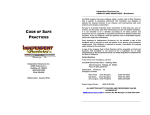Download PSSC DesignTech MS2012
Transcript
No. 43/2 SECRETARIAT OF THE PACIFIC BOARD FOR EDUCATIONAL ASSESSMENT Marking Schedule 2012 © Secretariat of the Pacific Board for Educational Assessment, 2011 Level 5, Vanua House, Victoria Parade, Box 2083 Government Buildings, Suva, Fiji. Telephone: (679) 3309622, 3315600, 3302141 Fax: (679) 3378598, 6793378599 All rights reserved. No part of this publication may be reproduced by any means without the prior permission of the Secretariat of the Pacific Board for Educational Assessment. DESIGN UNDERSTANDING EXAMINATION Question A1 1. 2. 3. 4. 5. C D B A D (10 marks) 6. A 7. A 8. B 9. A 10. A Question A2 1. 2. 3. 4. 5. 6. (6 marks) G C A F B D Question A3 (8 marks) 1. A statement about the need of a product and any expectations about the solution. 2. describes the problem, sets specifications and describe tasks. 3. It describes the things about the design which is fixed and also defines the things which are free to change. 4. To help the designer to determine a solution that is most accurate and closest to the needs of the client. 5. The producer might produce a wrong product thus client is not happy – Producer has also wasted his time, resources and money on a product not needed or wanted. 6. Producer talks to the client again to clarify the confusion before he can start working. Question A4 (12 marks) 1. Design brief two (2) Because;‐ It is more detail than the other two, example it states that (1) it is a hot local food dish. (2) it is for Tom and Mary who are diabetics (3) it is for their lunch. 2. The specifications will be :- 1) A diabetic dish, 2) It is a hot local food dish is for lunch 3)It 3. A closed design brief is more specific and detailed in it’s requirements. An open design brief provides the designer with freedom to explore and create a wide range of possible outcomes. 4. –Internet Library using text books Visit local hospital Interview a nurse, doctor or a diabetic patient Research questionnaire 5. So that any mistakes along the stages are identified and fixed earlier than too late. If too late, will make things complicated and product will not be of quality. Question 5 (5 marks) 1. A systematic problem solving strategy with criteria, constraints and tools used to develop many possible solutions to solve a problem or satisfy needs and to narrow down the possible solutions to one final choice. 2. Evaluation is to make judgement of the worth of something example, a product, a topic etc. When evaluating a product follow the designing process. After evaluation you make constructive decisions. 3. The answer to how you intend to develop your product as a result. Question A6 (9 marks) Answers will vary due to different projects evaluated in the different major areas. Here is just an example. A product evaluated in textiles – A child’s (3-6yrs) garment. A gathered skirt and a blouse. 1. Choice of material – Fabric used was not cotton but a manmade blend. Picked because of its bright floral colour and designs, not on quality fabric. As a beginner, should choose cotton even if it is dull, and unattractive but, easy to handle and work with. Also should use a matching thread to the colour of the fabric in order to hide crooked stitches. 2. Choice of equipment, tools and processes. –Choice were alright because they were the tools/equipments to use but it how you use them that will determine quality work. It takes practice to be good at something and confidence as well. Machine stitches were crooked due to wrong measurements, wrong pinning, uneven folding and then crooked stitching when not confident on the machine. More practice on the using the tools/equipment can be perfect on samples before working on the final product. 3. Quality on workmanship – Although the garment is completed, quality of work on the different processes still needs improvement. Hems are not evenly folded. Needs more trialing on even folding. The prints on the top blouse do not flow or match with the skirt prints. Laying out the patterns to cut should take extra care of the prints. Although it is using up more fabric but it is a skill to learn as well. 4. Do you think the product has a potential market. – Yes! But the weaknesses pointed out must be considered and applied for improvement. A client who may not notice these weaknesses because she knows nothing about sewing and may be a regular customer but others who sees these weaknesses will go somewhere else to buy. Quality is very important before you start a market so that it grows as well as the market you start is strong and can compete with others who give competition. Your market grows and you are consistent with your products. SECTION B: WOOD TECHNOLOGY QUESTION B1 (19 marks) 1. Diagrams below show how end of timber shrinks when moisture evaporates, depending on how log are sawn. a) Name two common ways of sawing or cutting the log into timber. One mark each for the correct name of the timber conversion (2 marks) i) Name: Plain sawn or Tangential sawn ii) b) c) Name: Quartersawn Draw the grains or growth rings on the diagram above to show how logs were cut. One mark each for the correct draw of the growth/grain rings (2 marks) There are 2 common sources of defects in timber, natural defects and defects which arise once the tree is cut down, either through poor handling or poor seasoning of the tree. Briefly describe the following common defects and the cause of each defect. (4 mark) i) ii) iii) Checks: Separation of wood, fiber, along the length of the log – caused by uneven shrinkage. Shakes: Separation of wood starting from the pith of the tree Knot: Results from a branch being cut during or before conversion of timber Two marks for the correct description and two marks for the correct courses of each defect d) Warp is a type of timber defects. In the space below: i) Briefly explain the causes of the defect ii) Sketch the type of timber defect given (2 marks) (2 marks) i. Bow Warp: Variation of a piece of timber from its true surface in length, caused by uneven shrinkage (1mark) and right sketch (1 mark) One mark for the correct explanation of the cause of the defect and one mark for the correct sketch of defects ii) Cup: (1 Variation of a piece of timber from its true surface in the length and width, caused by uneven shrinkage. mark) and right sketch (1 mark) One mark for the correct explanation of the cause of the defect and one mark for the correct sketch of defects Give ONE way of slowing down the shrinking of the width than the length of the board during seasoning (2 marks) Paint the end of the timber during seasoning to slow down its shrinkage Put strip of metal or plastic at the end of timber during seasoning to slow down its shrinkage One mark each e) 2. Identify and describe the 3 factors affect the strength of timber. (3 marks) i) Moisture content: Wood increases its strength as it dries ii) Specific Gravity is an excellent index of the amount of wood substance a piece of dry wood contains, it is also a good indicator of the strength properties of wood. iii) Temperature: In general, wood tends to become weaker when its temperature is raised and stronger when temperature is lowered. One mark each) 3. Briefly explain the differences between the hardwood and softwood in term of water‐ conducting cells. (2 marks) Soft Wood: The wood of gymnosperms is commonly referred to as softwood, and sometimes as non‐ pored wood. The bulk of softwood is made of long narrow cells, or tracheids, that fit closely together. Hard Wood: Broad‐leaved trees, like vesi, are hardwood tress. The wood of these trees is made up of two distinct types of cells, vessels and fibre cells. One mark each QUESTION B2 (19 marks) 1. Briefly explain the processes of construction of the following manufactured materials and its application Particle Board: Particleboard is manufactured by mixing wood particles or flakes together with a resin and forming the mix into a sheet. The raw material to be used for the particles is fed into a disc chipper with between four and sixteen radially arranged blades. The particles are first dried, after which any oversized or undersized particles are screened out. Application: For interior use, weight and cheaper than hard wood One mark each for the explanation of the manufactured of particle board and one mark for the application. (2 marks) ii) Plywood: Plywood is a manufactured wood panel made from thin sheets of wood veneer. It is one of the most widely used wood products. It is flexible, inexpensive, workable, re‐usable, and can usually be locally manufactured. Application: Plywood is used instead of plain wood because of its resistance to cracking, shrinkage, splitting, and twisting/warping, and its general high degree of strength. One mark each for the explanation of the manufactured of plywood and one mark for the application. (2 marks) 2. Study the storeroom step given below and answer the following questions. a) Complete the table of the cutting list below of the storeroom step. Top been has done for you as an example (2 marks) NUMBER OF PIECES TOTAL LENGTH WIDTH THICKNESS TOP 1 420 mm 150 mm 18 mm LEG 2 1,200 mm 100 mm 18 mm RAIL 2 260 mm 80 mm 18 mm STRINGER 2 1,400 mm 130 mm 18 mm TREAD 2 840 mm 130 mm 18 mm PARTS Total Length = 4120 mm Half mark for correct row b) Calculate the cost of the timber required to make the storeroom step, if all pieces for the steps are to be cut from 150 mm x 25 mm. The cost of the 150 mm x 25 mm is $ 7.40/m. (1 mark) Total Length = 4120 mm = 4.12 m Cost of the timber = Cost per meter x Total Length = $ 7.40 / meter x 4.12 m half mark = 30.488 = $30.49 half mark c) Complete the table below with the material you selected for each components and the supported property of your chosen material. (4 marks) PARTS SUGGESTED MATERIAL(S) PROPERTIES TOP Plywood High strength LEG Hardwood Tough RAIL Plywood Little affect by environment STRINGER hardwood Tough One mark for suggested material and property of each part, there are also correct answers d) State 2 factors that considered when deciding the finishing for the storeroom step. (1 mark) i) Environment What type of finishing is available ii) Half mark each, but there are also correct answers e) You are given a 150 mm x 25mm x 400 mm piece of timber to make one trend of the storeroom step. List the correct steps with the correct hand tools you use to set out, cut and clean up the final shape of the tread. (3 marks) CORRECT STEPS 1) Timber preparation 2) Marking REQUIRED TOOLS Straight edge, square, plane, pencil Divider, pencil, square Saw, Files, plane, square, radius gauge 3) Cut, Clean up and Test One mark for the correct step and the correct tools for each step f) Pick any 2 hand tools from part e) and state 2 safety precautions in using them. (2 marks) Tools Safety Precautions 1) Store it separately from other tools 1) File 2) Clean it with file card after use 1) Do not store or mix straight edge with other tools as 2) Straight Edge the edges may be damage and ruin its accuracy. 2) For storage apply a thin film of oil on the surfaces to avoid rusting Half mark for each correct safety precaution (14 marks) QUESTION B3: 1. Study the student’s study desk given below and answer the following questions. a) Name and draw any 2 possible wood joint that could be used to join the leg and the rail (4 marks) Possible Wood joint 1: Mortise and Tenon Joint Possible Wood joint 2: Butt Joint One mark each for the correct name of joint and one mark each for the correct sketch of the wood joint. There are other possible wood joint that could be used for this question. b) The table top will be made out of 4 x 100 mm x 25 mm x 750 mm hardwood. You need to join them using towel joint. Explain with the aid of diagrams the 4 main steps of doing towel joint with tools required for each step. (6 marks) STEP 1 Timber preparation STEP 2 Marking STEP 3 Drilling and Cutting STEP 4 Assembling TOOL REQUIRED Straight edge, square, ruler, pencil, plane, marking gauge TOOLS REQUIRE Divider, pencil, ruler, marking gauge TOOLS REQUIRED Saw, drilling machine, ruler, pencil, measuring tape TOOLS REQUIRED Square, glue, clamp, straight edge, measuring tape Half mark each for the correct steps, and one mark each for the correct tools required. c) Name another possible material that could be use for the table top instead of the 4 x 100 mm x 25 mm x 750 mm hardwood. Compare them by stating the advantage and disadvantage of each material. (2 marks) Material 1: Hardwood Material 2: Plywood Advantage: Advantage: It has a hard surface with good resistance to wear Easy, one piece of plywood to cover the table top Disadvantage: Disadvantage: It does not give the good natural appearance if Need more work, time and skills for towel joint the leg of the table is out of hard wood. Half mark each for the advantage and disadvantage of the material. There are other correct answers. d) The legs for the Student Study desk will be made from 75mm x 75 mm softwood timber. The cost for the 75mm x 75mm is $9.75 per meter. Calculate the cost for the leg of the Student Study desk. (2 marks) Total Length = 2400 mm = 2.4 m Cost of Timber = Cost per meter x Total Length = $ 9.75 / meter x 2.4 m = 23.4 Cost = $ 23.40 One mark for step 1 and 2 and one mark for step 3 and 4. MAJOR 2: METAL TECHNOLOGY QUESTION B4: Engineering Materials (10 marks) a) List and discuss three (3) mechanical properties of engineering materials. (3 marks) i) Ductility: The ability of a material to change shape without breaking or cracking. (example car body panel) ii) Elasticity: The ability of material to return to its original shape having been deformed by being placed under load. (leaf and coil spring) iii) Toughness: The ability of a material to withstand heat and impact. The tough material is neither soft nor hard. (example engine valve, crane hook) One mark each for the correct property and explanation and half a mark if only one is correct. There are other property like Tensile strength, brittleness, hardness, malleability, fatigue and so forth. b) List and briefly discuss two (2) factors that are used as bases of materials classifications. i) Chemical composition of material ii) (2 marks) Internal Structure of material One mark each. There are other factors like mode of occurrence in nature, metal and non metal, raw and manufacturing material and so forth c) Briefly describe the following heat treatment processes: Heat Treatment Processes (3 marks) Explanation Quenching is the heat treatment of material to become more 1 Quenching resistant to penetration and abrasion. Annealing is a heat treatment which softens the material so it Annealing 2 can be bent or formed (cold worked) allow the material to be easily machined Tempering is a secondary heat treatment process used to Tempering reduce the high hardness caused by quenching from high 3 temperature One mark each for the correct explanation d) (2 marks) Briefly explain with h example th he differencee between Fe errous and Non‐ferrous m metal. Ferrouss are metal tthat compose chiefly by iiron like mild d steel, iron a and cast iron n while non‐fferrous are pure m metal that does not conta ain iron like a aluminium, copper, tin an nd so forth One mark for the ccorrect expla anation of ferrous metal and one ma ark for the co orrect explan nation of thee non‐ferrrous metal. QUESTION B5: 1. Hand Tools and Machin nes (16 marks)) Hand TTools Complete tthe table bellow by correctly name th i) he hand toolss and its use. 1 N Name U Use Centre P Punch To providee witness ma arks on centrre lines and reference lines Bevel Sq quare For transfeerring angless 3 Scribing Block To be used d with a surfa face table to scribe parallel lin nes to the ma achines surfa ace 4 Combina ation Square SSet To mark lin nes at any an ngle and to llocate the centre of ccircular objeccts 2 5 Block Sq quare or Try For markin ng square lin nes off plate edges or Square existing lin nes and rolleed steel sectio ons. 6 Scriber For making permanent scratched llocation or ob. line on a jo Half a m mark for thee correct nam me and half a a mark for th he correct usee of one hand tool (6 marks)) 2. Drilling and Drilling machine Diagram below is an end of a mild steel cylindrical rod of 150 mm diameter and 100 mm in length that needs to be drill with a 12 mm diameter at the centre to a 50 mm depth. i) Briefly describe how you safely hold and support the cylindrical work piece under a bench drilling machine for drilling (1 mark) A drilling vice that secure to the bed of the drilling machine with guide to cylindrical shape. One mark ii) If the material of the drilling bit is High Speed Steel (HSS) and the work piece is Mild Steel. Use a cutting speed (Vc) of 20 m/min, what is the rpm (revolution per minute) of the drilling machine for drilling a 12 mm diameter (d) hole. (2 mark) Formula: RPM Vc 1000 d RPM RPM RPM 20 m mm 1000 s m 12 mm 3 . 14 m mm s m 37.68mm 20000 m mm s m 37.68mm 20000 Half a mark Half a mark Half a mark Half a mark RPM = 530/min iii) List four (4) general safety precautions that must be observed when using drilling machine. 1. Always wear safety glasses (2 marks) 2. One man one machine 3. Keep your working area clean and tidy 4. Secure clamping of tool and work piece. Half a mark each, but there are more correct answers about machine safety iv) Complete the table below by list the causes of the following faults that can occur when drilling: (3 marks) Faults Cause(s) 1 Oversize hole Unbalanced sharpening – tip not in centre 2 Walls of hole rough Drill need to be sharpened 3 Wobbling drill Point of drill not in centre or web too wide 4 Drill squeaks and won’t cut Insufficient lip clearance 5 Drill has a chipped cutting edge Speed too high or harsh starts 6 Hole is out of round Unbalanced or incorrect cutting angles, or metal too thin for bit diameter Half a mark for each correct cause listed. There are other possible causes 3. Engineering hammer are classified as Impelling tools i) There are 3 most common types of Engineering hammer, name 2 of them 1) Ball pein (1 mark) 2) Straight pein 3) Cross pein Any two from the above three, half a mark each ii) Name 2 cares and safety on how you looking after engineering hammer 1) Never use a hammer without a wedge 2) Never hit two hammer faces together Half mark each, but there are other correct answers. (1 marks) QUESTION B6: Form Work (6 marks) When calculating the material for formed work, the golden rule to remember is to take measuring to the inside of square sharp bends and to use the centre line material (MD) for all curved work. i) Calculate the length of the bar required to bend the pipe bracket in the diagram below. Material: 75 mm x 10 mm flat bar (4 marks) 1 mark 1 mark 1 mark 1 mark ii) The piece of flat bar given below for the pipe bracket, mark out with the dimension and label ready for forming and rolls. (2 marks) One mark for correct marking and one mark for correct labelling QUESTION B7: FASTENERS AND WELDING (11 marks) 1. Fasteners i) Complete the table below by stating one advantage and disadvantage of the following common fasteners if you need to join galvanised sheet metal for a funnel. (3 marks) Type of Fasteners Advantage Disadvantage Soldering easy Not for joint that expose to high temperature Rivets strong Should not be used where severe vibration occur Screws Strong Complicated features and head styles One mark for each, there is also correct answers for the advantage and disadvantage of each fastener. 2. Welding i) Briefly explain the process of the following welding (3 mark) 1. Electric Arc Welding: The Electrical arc welding process is based on the principle of causing a low voltage, high amperage electric current to jump an air gap between the metal electrode and the base metal being welded. The extreme heat that the arc generates melts the base metal in a small area, and at the same time melts the filler metal in the electrode. The arc is either shielded or unshielded; the purpose of this is to protect the weld metal from contaminations in the surrounding air. 2. Oxy‐Acetylene Welding: The Oxy‐Acetylene welding is where oxygen and acetylene mix together and produce flames that suitable for most applications. The flames from the oxy‐ acetylene can be controlled over wide ranges of temperature. The temperatures could use to melt most metals and joint together or for brazing purposes. One and a half mark each ii) Give two (2) advantages of Arc Welding over other type of Welding. 1. Easy to take around hence no gas bottle (1 mark) 2. Can be use outside easy to set out for welding as long as electricity is available. Half mark each but there are other advantages over other type of welding. iii) List two (2) substances that need to be removed from an area where Arc Welding is to be carried out because of the risk of fire or explosion. (1 mark) 1. ________________________________________________________________ 2. ________________________________________________________________ iv) Label the diagram of an Arc Welding Process below. (3 marks) A E B C F D A: Electrode B: Flux coating C: Arc Stream 6000°C (molten globulets forced across the arc) D: Parent metal E: Solidified slag F: Deposited weld metal Half a mark each QUESTION B7: METAL TURNING PROCESSES (7 marks) 1. Given below is the picture and a drawing of a centre or prick punch. You are asked to produce this centre punch using a centre lathe. Material: High Carbon Steel Dimension: 3 '' 8 33 '' 4 a. Complete the order of how you make the centre punch on the centre lathe, first and last steps are given. (4 marks) 1. Facing work piece held in a chuck 2. Drilling center holes 3. Straight turning 4. Knurling 5. Taper turning 6. Hardening and Tempering One mark for each step b. Work Piece can be held in one of the following chucks for machining in a lathe. Briefly describe how these 3 chucks works. (3 marks) Three jaw self‐centring chuck: Round and hexagonal work piece can be mounted quickly and conveniently in a three jaw self‐centring chuck. The work is automatically centred to within 0.08 mm because all jaws move together to grip the work piece. Four jaw independent chuck: Where a high degree of accuracy is required, the work is generally mounted in a four jaw independent chuck. Each jaw of the chuck can be adjusted independently. The jaws are reversible and permit a wide range of work to be gripped either externally or internally. The face of the chuck has a number of evenly spaced concentric grooves which permit quick and approximate positioning of the chuck jaws. Collet Chuck: Generally, a collet chuck, considered as a unit, consists of a tapered receiving sleeve (often integral with the machine spindle), the collet proper (usually made of spring steel), which is inserted into the receiving sleeve, and (often) a cap that screws over the collet, clamping it via another taper. Each collet generally has only a narrow clamping range, which means a large number of collets are required to hold a given range of materials in the chuck, unlike with many other types of chuck that will generally cover a wide range of sizes. MAJOR 3: FOOD AND NUTRITION Question B9 1. 2. 3. 4. 5. (10 marks) 6. A 7. D 8. C 9. B 10. D A D B C B Question B10 1. 2. 3. 4. (7 marks) 5. B 6. G 7. A C D F H Question B11 (6 marks) 1. Iodine - Sea foods, Milk, Spinach, Iodized salt. Vitamin C – Citrus –( lemon, orange, grape fruit), Cabbage, Broccoli, Green pepper, Kiwi fruit, Straw berries, Brussels sprouts, Black currants. 2. To supply her own body and to provide the growing baby with a store of iron for the first few months after birth. 3. Increase the amount of fibre in her diet. Take gentle exercise like walking and swimming. Question B12 (12 marks) 1. Moulds, Yeast and Bacteria 2 Any one of these reasons. To avoid waste during the surplus To use up fruits and vegetables when they are cheap and plentiful and make available when they are not in season. To make full use of garden produce To introduce flavor and variety to the menu. To facilitate distribution and export of food on a commercial scale. 3. 1. Salting and drying 1. Roasting and drying 4. Fish in coconut cream 5. Protein Adding a chemical preservative – Salt and then dehydration when drying to make the fish dry with no moisture – Store above fire place wrapped in banana leaves. Dehydration - Roasting then getting rid of the skin, the seeds and the core. Cut them up into pieces and wrap in pandanus leaves and hang above fire place to get rid of moisture and make it dry. 6. Soak in water for one hour to get rid of saltiness. Cook in coconut milk with vegetables like capsicum, carrot and beans. Serve with a starchy like taro and raw vegetables like cucumber and tomato. This is to add more colour to it, improve the taste and texture at the same time making it more nutritious for my family to have. Question B13 (7 marks) 1. To ensure food safety and prevent spreading of infected diseases. 2. Any two of these answers. Wash hands under the tap with soap from the elbow up to the tips of the fingers and dry well Cover mouth with handkerchief or hand when coughing or sneezing then wash hand before continuing work Finger nails should be short and clean Long hair should be tied to the back -Remove excess jewellery on the hand – can harbor germs Wear clean clothes and apron and use clean tea towels and dish cloths Use clean equipments Work in a clean kitchen 3. High Risk Foods are foods that make a very good breeding place for harmful bacteria’s. When working with these foods, they need extra care in storing, preparing and cooking. Examples – Any two of these. Poultry, Fish, Eggs, Meat, Milk, Cream, Left over foods, Vegetables, Custards, Open canned food, Foods at Barbecue, salads. 4. When foods are frozen bacteria are not destroyed, they become inactive or they sleep because it is too cold for them. When these foods are thawed, the bacteria’s wake up and multiply very fast when the temperature increases or become warm. If they are refrozen again the number of bacteria has increased twice or triple and so the raw food now harbours more. If it is cooked but not cooked well, it can cause food poisoning to the consumer which if serious can lead to death. Question B14 1. Answers will differ – But some examples here; A Packed lunch for a 10 year old boy A balance meal for a breast feeding mother A Meal for a diabetic patient 2. Any 3. It is balanced Quantity is sufficient for one person Is attractive and appetizing 4. Any two of these as examples: Investigate what diabetic patients should eat Research suitable foods and possible dishes Modify and copy a suitable recipe Produce presentation concepts, work plan and order Produce and evaluate dish two of these examples: Watch and concentrate when slicing the meat using sharp knife Mopped spill water on the floor before it can cause a fall Switch off blender as soon as finished from it Turn off gas bottle when complete cooking (8 marks) Handle glass bowls with care, do not drop them Wash sharp knives alone from other dirty cutleries used 5. Any three points similar to these examples Foods that are suitable for a diabetic patient The cooking method to use is suitable for the client Amount is enough for one person The equipments to use are available The different colours of the ingredients chosen and when combined should stimulates the client’s appetite – example, green, red, orange, white and brown. MAJOR 4: TEXTILE AND GARMENT CONSTRUCTION Question B15 (10 marks) 1. C 2. B 3. A 4. C 5. D 6. A 7. C 8. B 9. D 10. A Question B16 1. 2. 3. 4. 5. 6. 7. D E H F A B C (7 marks) Question B17 (8 marks) 1. Explanations 1. Symmetrical – balance is where each half of the design is exactly like the other. 2. Asymmetrical - is the opposite, two halves of a whole design are different. Examples The answers might vary as long as they have something explained along the example below. 1. A jacket with two breast pockets and two hip pockets. 2. 3. A jacket with a breast pocket on one side may be balance by a hip pocket of the opposite side. (4 marks) 2 a) Makes a figure look tall and slim b) Makes a figure look shorter and wider c) Makes a figure look bigger (3 marks) 3. Accessories are additional items that are worn with clothes to complement the out fit. Examples, belts, shoes, bags, scarves, hats, jewelleries. (1 marks) Question B18 (11 marks) 1. Making your own patterns at home based on body measurements taken, calculations done and then patterns are drawn following the style of the garments 2. Patterns 1.Commercial Advantages Any of the following: Details instructions to follow both on the envelope and inside. Saves time to draft your own pattern Has the picture of the style Contains more than one size Cheap to produce 2 Home Pattern No alterations on pattern drafting since your own Disadvantages Not easily available, e.g., Vanuatu not sold in the shops Need to recheck measurements before use for alterations No choice – follow what is in the pattern – no creativity Expensive May not have the knowledge and skills in how to read and implement the information. Not much information on it Not easy to find resources measurement so it will fit you nicely Become creative in producing own styles to use No picture of style Only one size in an envelope May not have the knowledge and skills of how to make own. (4 marks) 3. Symbols Names Purpose It is where to increase or decrease the length either of bodice or the skirt 1. To lengthen or shorten here 2. Cutting line Where you will cut out the pattern pieces on fabric 3. Place on strait grain of fabric Place pattern pieces on grain or direction of warp yarns (6 marks) Question B19 (4 marks) 1. Weaving Loom 2. Plain 3. a) So that layout pattern correctly on the fabric according to the symbols. This is to avoid wasting material and time spent in doing something wrong. b) So that cutting out is done accurately. This way you don’t waste material money and time. Question B20 (5 marks) 1. Any one of the following: Waist band to add on the waist of the skirt. Fastenings to use could be zip and button and button at the center back of the skirt It would have waist darts on the front and on the back of the skirt Two side plain seams and a plain open at the back with a slit to allow for easy movement Hem at the edge of the skirt. Can add in seam pockets on the sides 2.Fabric, thread, Zip, Button, can be hook and eye, Knob and well. 4. Scissors, iron, Needle, Sewing Machine, Tape Measure, Pins, Unpicker, 5. For Materials:- l’ll use plain fabric only not floral because fitted skirts look nice in plain colours, and one colour only –eg. black. Also the fastening will be the same size and length of zip and just button and button hole So the machine can help out here. For tools:I would use a machine that can make button holes as well as sew on buttons so to work faster I would use an over locker to neaten the raw edges faster much faster and neaten and would all look the same – as a decoration too. Question 21 (6 marks) 1. Answers will vary depending on what the students did. This is just an example:Design and print a shirt that you will wear to the up coming school’s island night 2. -Investigate different shirt styles, designs and prints on the internet -Research local designs in the library -Interview local artist who paint and women who dye and print garments -Visit local handicraft and have a look -Talk to the organizers of the school island night -Find out what fabric absorbs dye easily and if it is available in the market 3. Solution - 3 ideas – 1. a) ”t’ shirt, b) a long sleeve shirt, c) a short sleeve island shirt. The solution chosen is short sleeve island shirt. Reasons for picking the third idea over the other two because: It’s an island night this shirt will suit the night, t shirt will not look formal, long sleeve will be too hot since we live in the tropics. Has slits on the sides so will be easy for movement in it Students are asked to dress in something comfortable and locally made – shirt is dyed and hand printed o -Has designs on it related to the local environment – Blue back ground – the sea with coconut palm trees swaying and local flowers. 4. Examples: -That fabrics have different characteristics -Once you know the type of fabric then you will use it correctly and it can last. -You should not buy fabric because of it colour or design on it, you must know what it is and if it will look good on you. -Not all styles will look good on you, therefore, must know your figure type and what colour suits you best so that what you make and wear looks good on you, not the opposite. MAJOR 5: TECHNICAL GRAPHICS Question B 22 (12 marks) a) Complete the Table below with the missing drawing examples and applications. Line Description Drawing Example Application To indicate centre lines, pitch lines, path movement, developed view, material for removal and features in front of a cutting plane Continuous thick line Thin double‐dashed chain line Thick chain line To indicate adjacent parts, alternative and extreme positions of moving parts, centroidal lines and tooling profiles To indicate surfaces that must comply with certain requirements such as heat treatment or surface finish ½ mark for the blank ones (3 marks) b) Complete the Table below with the name(s) of the following symbols and scale. Symbols Name(s) Scale of 1: 1 R Full Size Radius Slope First Angle Projection Square Counter bore or Spot face ½ mark each (3 marks) c) Use the projection of the triangle ABC given below to determine the: i. True shape of triangle ABC true shape is the triangle A’’B’’C’’ (2 mark) 1 mark for correct shape, 1 mark correct construction lines ii. The true length of the two sides (2 marks) AB: 55 mm ± 1mm BC: 40 mm ± 1mm iii. The true angle of inclination of the triangle ABC to the horizontal plane H : 23° ± 2° (2 marks) QUESTION B 23 (18 marks) a) Study the given Oblique hexagonal pyramid and answer the following questions i) Find the true length of the given sides of the hexagonal pyramid. (2 marks) ii) Develop the given hexagonal pyramid using any method of your own choice. (3 marks) b) Vector Diagrams and Force in Beams i) Determine the resultant force and point of application of the given co‐planar, concurrent force system. (3 marks) ii) Given below is the Space diagram of parallel forces acting on a beam. Use the Funicular, Force and Polar diagram to determine the: (7 marks) 1) The Position of the resultant force 2) Reactions RL and RR at the supports c) Given are the plan and incomplete elevation of interpenetrating prism. Complete the Elevation by drawing the lines of intersection. (3 marks) QUESTION B 24 (20 marks) a) Draw the following views of the Support Bracket, shown below, in Third Angle Projection: A. A front view in direction of A (3 marks) B. A side view in direction of B (2 marks) C. A top view (2 marks) Give two dimensions for each view SUPPORT BRACKET A. FRONT VIEW ½ mark for the correct principle ie. Third Angle projection ½ mark for spacing ½ mark for line work ½ mark for accuracy ½ mark dimension ½ mark neat and tidy B. SIDE VIEW ½ mark for line work ½ mark for accuracy ½ mark dimension ½ mark neat and tidy C. TOP VIEW ½ mark for line work ½ mark for accuracy ½ mark dimension ½ mark neat and tidy 31 DO QUESTION B _____ Part a) here (SUPPORT BRACKET) 32 b) Study the diagram below and answer the following questions Sketch: 1) An Isometric view with corner Y nearest the viewer in the space below. Print the correct letter on each face. (2 marks) 1 mark for correct oblique shape, 1 mark for correct print of letter to correct face 33 2) An Oblique view. Print the correct letter on each face. (2 marks) 1 mark for correct oblique shape, 1 mark for correct print of letter to correct face c) Draw the given shaped block in two point perspective. Show all construction lines. 34 (4 marks) Mounting Braacket above and answer the followin ng questions d) Study the M (5 marks) MOUN NTING BRA ACKET 8 holes (incclude those ffor thread d cutting) 1 How m many holes require drillin ng? 2 What is the overalll height of th he Mountingg Bracket? 67 7 mm 3 What is the dimen nsion A in mm m? 35 5 mm 4 What is the dimen nsion B in mm m? 46 6 mm 5 What is the dimen nsion C in mm m? 32 2 mm 6 What is the specifiied diameterr of hole D? 11 1 mm 7 What is the tolerance of the laarge hole? 0.0 03 mm 8 What is the radiuss of fillets and d rounds? 5 mm 9 How m many threadeed holes are on the Mou unting Brackeet? 5 h holes 10 What dihedral anggle is used fo or projection of views? Half ma ark each 35 First Anglle Projection n MAJOR 6: SMALL ENGINE AND AUTOMOTIVE MECHANICS QUESTION B 25 (10 marks) 1. D 2. C 3. A 4. A 5. D 6. D 7. B 8. B 9. A 10. C QUESTION B 26 1. 2. (5 marks) Where should shop solvents and combustible materials be stored? __in marked storage rooms______________________________________________ (1 mark) What level of eye protection is required when using an oxy‐acetylene torch to cut mild steel? __goggles with a #5filter________________________________________________ 3. 4. 5. (1 mark) Why should an incandiscent trouble light never be used in the shop floor? _explosion hazard_____________________________________________________________ (1 mark) What tapeline emission requires you to vent tailpipe gas to the shop exhaust extraction system any time an engine is run in a garage? __Carbon Monoxide ____________________________________________________ (1 mark) Name the type of fire extinguisher that can be safely used to put out class A, B, C and D category fires? __Dry Chemical____________________________________________________ (1 mark) 36 QUESTION B 27 1. 2. 3. (15 marks) Explain the purpose of the primary winding in an ignition system. The purpose of the primary winding is to induce current into the secondary winding to fire the spark plug. (2 marks) How many valves are there on a two cylinder 4‐stroke‐cycle small engine? __2_________________________________________ (1 mark) Define Backlash End to end movement of two gears on a shaft (1 mark) 4. The figure below is a picture of a Two‐Stroke diesel engine. Which letter represents the: i. Oil ii. Fuel Injector iii. Air Intake iv. Piston v. Crank Case vi. Exhaust Valve 5. __E_____ __B_____ __C_____ __D_____ __F_____ __A_____ (6 marks) In a paragraph explain how the Two‐Stroke Engine works. You may use the figure above in your answer. When the piston is at the top of its travel, the cylinder contains a charge of highly compressed air. Diesel fuel is sprayed into the cylinder by the injector and immediately ignites because of the heat and pressure inside the cylinder. The pressure created by the combustion of the fuel drives the piston downward. This is the power stroke. As the piston nears the bottom of its stroke, all of the exhaust valves open. Exhaust gases rush out of the cylinder, relieving the pressure. As the piston bottoms out, it uncovers the air intake ports. Pressurized air fills the cylinder, forcing out the remainder of the exhaust gases. The exhaust valves close and the piston starts traveling back upward, re‐covering the intake ports and compressing the fresh charge of air. This is the compression stroke. As the piston nears the top of the cylinder, the cycle repeats with step 1. 37 QUESTION B 28 1. 2. Atmospheric pressure affects the operation of small gasoline engine at various altitudes. What is atmospheric pressure at sea level? __14.7 psi______________________________________________________________ (1 mark) Explain the function of the following components of a small engine: i. Muffler Small gas engines, especially two‐stroke engines, are noisy when they operate. A muffler reduces the sound of the exhaust gases by passing them through baffles._____________ ii. Spark Plug A spark plug is an insulated electrode that is screwed into the top of the engine cylinder. High‐voltage timed electricity from the magneto travels by wire to the spark plug. The base of the plug has an air gap of about 0.030 inch (30 thousandths of an inch), which the current must jump._____________________________________________________ iii. 3. 4. (20 marks) Throttle The throttle controls the amount of fuel‐air mixture that enters the engine from the carburetor. The throttle thus controls the speed of the engine._____________________ (6 marks) What should be done to a battery after performing a hydrometer test and cell 1 has a specific gravity of 1.279 and cell 2 has a specific gravity of 1.225. ___Replace battery____________________________________________________________ (1 mark) What is the most likely problem if an old carbureted car starts fine but quickly begins running rough and blowing black smoke out the tailpipe? Black smoke is caused when the mix of fuel and air becomes un‐balanced. Normal mixture is 14.5 parts air to1 part fuel. When the fuel to air mixtures change because of a malfunction the mixture can go as high as 14.5 to 2 or 3, two to three times the proper amount. The black smoke is the excess fuel generated from the rich mixture and can be cause by one of the following: Plugged Air Filter Shorted or stuck fuel injector Failed fuel pressure regulator Vacuum leak Shorted Computer Sensor (2 marks) 38 5. 6. 7. 8. Explain how to clean carburator parts. Use carburetor cleaner and lint free cloths or paper towels to remove all built up brown or green gunk, varnish, and other contamination from the metallic parts. Pay particular attention to the machined passages and metering holes. WARNING: Carburetor cleaner is both flammable and the fumes are toxic. Do all cleaning away from open flames and outdoors if possible. Wear eye protection. The stuff will also eat plastics including some plastic eyeglass lenses. Take care where non‐metallic parts are still in place as extended contact with harsh solvents may degrade their properties (inlet seat and primer bulb, if present). Low pressure compressed air may be used to blow out passages but only use this on the fuel line from inside the carburetor body ‐ else you may end up with the inlet seat clear across the driveway never to be found again. DO NOT use wires or metal instruments to clear any of the passages as their size is critical. The small hole in the hollow bolt on the bottom is most critical. Make sure it is cleaned down to the shiny brass and that this hole is unblocked and fully open: (3 marks) Your friend is interested in learning auto repair. Advise on what would be an easy first project. When you look at an auto repair diagram or service manual the first step in most auto repairs is to disconnect the vehicle's battery. The preferred procedure is to disconnect the negative side of the battery first, and I also like to disconnect the positive side as well. Just in case the ground side should contact a solid ground by accident. A lot of do it yourself auto repair mechanics get so anxious to dive into the repair that they forget this first step. If you are replacing an alternator or starter and forget to disconnect the battery, the sparks are going to fly. (2 marks) When changing a tire explain the best procedure. Install all the nuts finger tight, and then tighten them in a four – or fve pointed star pattern to one half of the torgue specification found in the owner’s manual, and then again in sequesce to the full value. And use a proper torque wrench. (2 marks) What is the main challenge facing automotive industry today? Government regulations regarding fuel efficiency and emission controls. 9. (1 mark) What two things do your car’s brakes use to multiply the force of your foot depressing the brake pedal and stopping the car? Different braking components use mechanical advantage and hydraulic force multiplication to translate the force of your foot on the pedal to stopping power for the car. (2 marks) 39







































